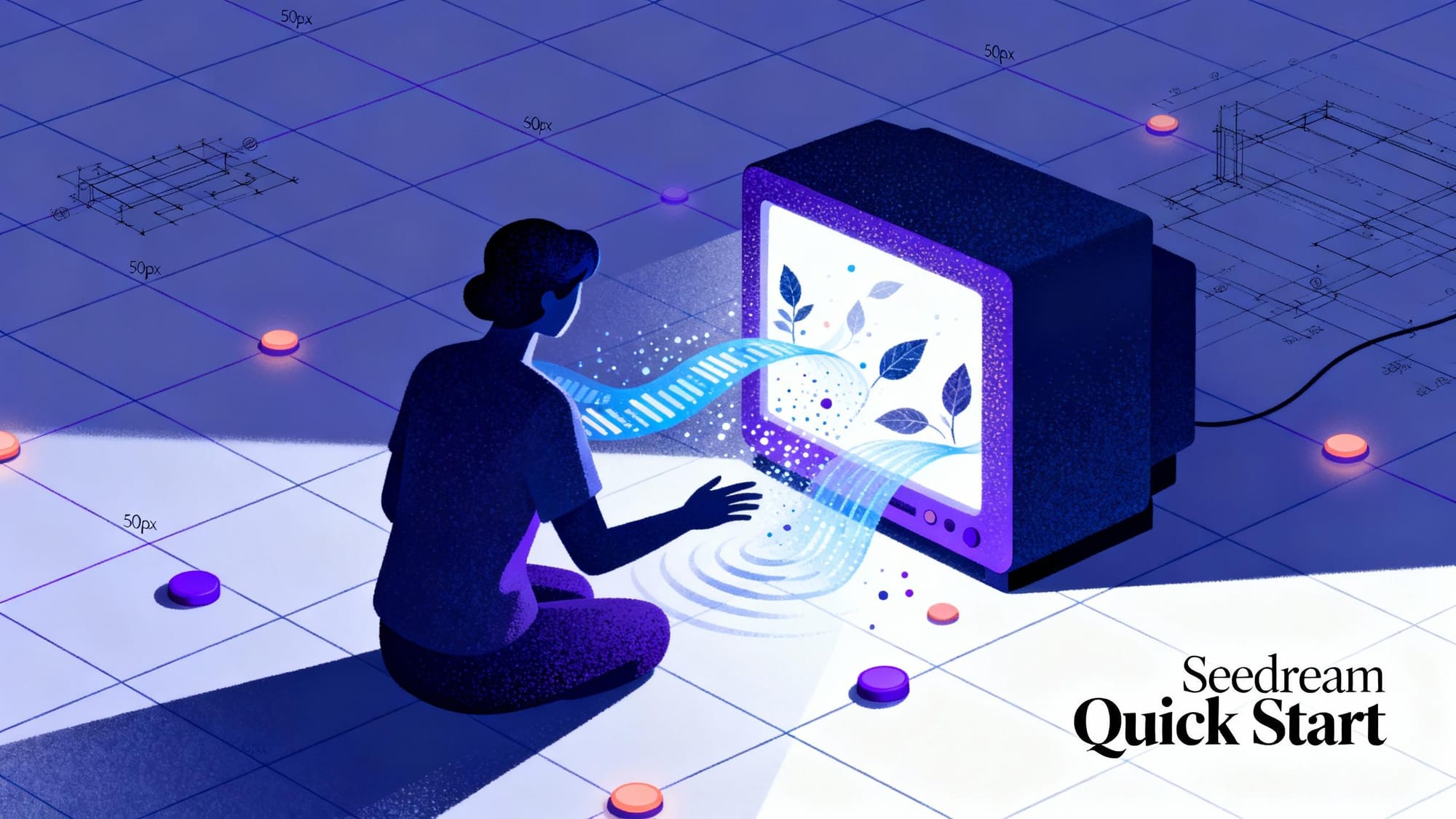Quick Start Guide Seedream 4.0: The Smarter Way to Create Visuals
Kickstart your creativity with this quick start guide Seedream 4.0. Learn how to craft striking AI visuals. Read now and start creating instantly!

Want to create professional-quality visuals without hours of editing? Seedream 4.0 might be exactly what you’ve been looking for.
It’s an advanced text-to-image model developed by ByteDance and hosted on Segmind. With just a few words, you can turn ideas into sharp, realistic images that look expertly crafted.
In this quick start guide Seedream 4, you’ll learn how to set it up, explore its versions, and use its features to create stunning visuals with ease. Ready to see how simple it can be? Let’s get you started.
In a Hurry? Here’s the Short Version:
- Seedream 4.0 simplifies AI visual creation. You can generate, refine, and sequence visuals directly on Segmind without manual setup or installations.
- Each model variant serves a distinct role. Choose between text-to-image, inpainting, frame sequencing, or edit-sequential modes to match your creative workflow.
- Well-structured prompts deliver precision. Using clear subjects, lighting, and style cues helps produce consistent, high-quality visuals across multiple outputs.
- PixelFlow enhances automation. Connect Seedream 4.0 with other Segmind models for end-to-end workflows.
- Segmind unifies creativity and speed. Developers and creators benefit from fast rendering, reliable API integration, and workflow automation in one cloud platform.
Getting the Most Out of Seedream 4.0: What Can It Do For You
Seedream 4.0 lets you turn ideas into detailed, realistic visuals faster than ever. Built by ByteDance and hosted on Segmind, it delivers control, accuracy, and speed in one place. You can access it through the Segmind Models Hub, using the web interface or API for instant creation and editing.
Before getting started, it’s important to pick the right version. Each model in the Seedream 4.0 lineup is designed for a specific creative goal:
Model Name | Purpose | Best For |
bytedance/seedream-v4 | Text-to-image generation | Creating new, high-quality visuals from prompts |
bytedance/seedream-v4/edit | Image inpainting and refinement | Adjusting or enhancing parts of existing visuals |
bytedance/seedream-v4/sequential | Frame-based generation | Producing connected images for sequences or animations |
bytedance/seedream-v4/edit-sequential | Editing and sequencing | Creating evolving visuals across multiple frames |
Each version supports a different creative flow. You can switch between them easily within Segmind’s interface to match your project’s needs.
Once you select a model, Seedream 4.0 opens up multiple ways to create:
- Concept Art and Illustration: Build characters, props, and environments with consistent detail.
- Product and Marketing Visuals: Generate lifelike renders and promotional images ready for campaigns.
- Image Editing: Use /edit or /edit-sequential to correct details, enhance quality, or replace elements.
- Storyboarding and Sequencing: Create frame-by-frame visuals for storytelling using /sequential.
- VFX Previsualization: Design lighting, mood, and camera perspectives before production begins.
You can also combine Seedream 4.0 with PixelFlow, Segmind’s visual workflow builder, to automate multi-stage outputs. Whether you’re crafting static art or dynamic sequences, Seedream 4.0 gives you precision, speed, and full creative control.
Create studio-quality visuals instantly with Seedream 4.0 on Segmind!
Quick Start Guide Seedream 4.0: Step-by-Step Setup
Getting started with Seedream 4.0 is simple. You can experiment, refine, and build visuals without installing anything. Each step below helps you move from setup to output efficiently.
Step 1: Set Up Your Workspace
Start by visiting the Segmind Models Hub. Sign in and open a project space where you can organize your renders.
- Search for Seedream 4.0 in the model list.
- Choose your preferred variant based on your creative goal.
- Click “Run Model” to launch it instantly or “Open in PixelFlow” to connect it with other models for multi-step workflows.
PixelFlow lets you chain models together. You can build automated processes such as text-to-image, followed by image-to-video generation, or apply additional filters and effects. This setup provides flexibility without requiring manual switching.
Also Read: The Ultimate Guide to the Best AI Image Generation Models in 2025
Step 2: Craft a Strong Prompt
Your prompt decides how the model interprets your idea. Keep it simple, specific, and structured.
Prompt format: subject + detail + lighting + lens + style
Examples:
- “a misty mountain temple, sunrise light, cinematic tone”
- “portrait of a cyberpunk pilot, blue neon lighting, 85mm lens, ultra detailed”
Avoid overloading prompts with mixed styles or too many adjectives. Test small variations to fine-tune results. Each version of Seedream 4.0: standard, edit, sequential, or edit-sequential, responds precisely to the structure and tone of your words.
Step 3: Generate, Edit, or Sequence Visuals
Once your prompt is ready, start creating. Select your variant based on the task:
- Use /seedream-v4 for text-to-image generation.
- Use /edit for image correction or regional edits.
- Use /sequential for frame-based storytelling or motion-like sequences.
- Use /edit-sequential to apply edits across evolving scenes.
Before rendering, adjust essential parameters:
Setting | Purpose |
Aspect ratio | Defines image width and height composition |
CFG scale | Controls prompt adherence vs creative variation |
Batch size | Generates multiple outputs in one session |
Preview your results in the Segmind interface. Make changes, re-run the generation, and save your best renders. If you’re building a series or multi-model workflow, use PixelFlow to publish, repeat, or automate the entire process.
Also Read: How to Fix “Can't Generate Your Video. Try Another Prompt”
Best Practices for Exceptional AI Visuals: How to Refine Your Outputs in Seedream 4.0
Creating sharp, consistent visuals with Seedream 4.0 depends on clarity and control. Each setting, prompt, and workflow choice influences the final image. Follow these practices to make every output stand out.
1. Keep Prompts Clear and Contextual
A well-structured prompt gives the model a clear direction. Write in a logical order that defines the subject first, followed by context and style. Keep descriptions natural and purposeful.
Use this simple sequence when building prompts:
Element | Purpose | Example |
Subject | The main focus of your image | “portrait of a warrior” |
Context | Setting or background | “standing in rain under neon lights” |
Lighting/Style | Visual tone and detail | “cinematic lighting, 85mm lens” |
Tips:
- Avoid using conflicting adjectives such as “soft yet harsh lighting.”
- Keep stylistic keywords focused and minimal to prevent mixed results.
2. Adjust Output Quality Thoughtfully
Technical control helps maintain image consistency. Resolution, sampling steps, and CFG scale all influence clarity and creativity.
- Resolution: Use higher settings for detailed renders and lower ones for previews.
- Sampling Steps: Increase step count for sharper edges and smooth gradients.
- CFG Scale: A moderate value keeps the model close to your prompt without restricting variety.
Experiment with aspect ratios to match your visual purpose, such as 1:1 for portraits or 16:9 for cinematic frames.
3. Experiment Through PixelFlow
Linking Seedream 4.0 with other models inside PixelFlow unlocks broader creative control. You can connect tasks into one automated workflow, producing layered results efficiently.
Example sequence:
Seedream 4 → Image-to-Video → Upscaler
This workflow refines still images into motion sequences and completes them at a higher resolution. You can save, share, or reuse these pipelines with your team, keeping projects consistent across revisions.
Common Mistakes to Avoid When Using Seedream 4.0
Even small errors in setup or prompting can affect your final results. Paying attention to model choice, settings, and consistency helps maintain visual quality.
Avoid these common issues:
- Overstuffing prompts: Mixing unrelated styles or subjects leads to confused compositions and weak focus.
- Wrong model variant: Each version of Seedream 4.0 serves a purpose. Using /edit for generation or /sequential for static images reduces precision.
- Skipping CFG or step tuning: These control the structure and sharpness. Ignoring them can cause flat or noisy results.
- Lighting or mood inconsistency: In sequential frames, mismatched tones break continuity. Keep parameters aligned for smooth transitions.
Small adjustments or tweaks often lead to significant visual improvements.
Explore Segmind’s AI models and start creating now!
Integrate Seedream 4.0 into Segmind PixelFlow
PixelFlow is Segmind’s visual workflow builder that lets you automate media creation by connecting multiple AI models. Instead of running each model separately, you can design a comprehensive visual pipeline that seamlessly transitions from text input to finished output. This structure helps you produce multi-stage results efficiently.
You can connect models either sequentially (one after another) or in parallel (processing multiple paths simultaneously). This gives you flexibility in handling complex visual projects, from still image generation to animated sequences.
Here’s what you can achieve by linking Seedream 4.0 inside PixelFlow:
- Multi-stage generation: Start with Seedream 4.0 for text-to-image creation, then connect an upscaler or image-to-video model for extended outputs.
- Automated refinement: Add enhancement stages, such as background cleanup or lighting correction.
- Parallel workflows: Run multiple visual versions side by side for faster comparisons.
Example flow:
Seedream 4 → Image-to-Video → Upscaler
This setup transforms static renders into motion visuals with improved detail and resolution. You can save, reuse, or share your workflows for future projects.
Also Read: Can You Copyright Images Made by AI? Key Takeaways from the Case
Why Developers and Creators Choose Seedream 4.0
Seedream 4.0 meets the needs of both developers and creators by combining speed, accuracy, and workflow flexibility within Segmind. It adapts to individual projects, whether you’re coding an automation pipeline or designing concept art.
User Type | Key Benefits |
Developers | Access Seedream 4.0 through API for scalable deployment, rapid testing, and integration into custom applications. Automate tasks or connect it with other models using PixelFlow. |
Creators | Generate, edit, or sequence visuals instantly with high precision. Control lighting, detail, and mood without external tools. |
With Segmind, everything stays in one platform: model access, automation, and workflow chaining. You work faster, maintain consistent outputs, and focus on creativity instead of setup.
Conclusion
Seedream 4.0 gives you everything you need to create quickly and with precision. Each model version supports a different creative goal, whether it’s generating, editing, or sequencing visuals. Clear prompts and easy adjustments help you produce high-quality results in minutes.
You can access Seedream 4.0 directly on Segmind and begin experimenting right away.
Try Combining Seedream 4.0 with Segmind’s Image-to-Video Templates
FAQs
Q: Can I combine Seedream 4.0 outputs with other AI tools for video production?
A: Yes. You can connect Seedream 4.0 with Segmind’s image-to-video models in PixelFlow to build smooth, automated video creation pipelines.
Q: How can I control the artistic consistency across multiple generated images?
A: Reuse prompt structure, lighting terms, and CFG values. Keeping these settings stable ensures uniform style across all frames or sequences.
Q: Does Seedream 4.0 support collaboration for creative teams?
A: Yes. You can share workflows through PixelFlow, allowing teams to edit, refine, and reuse models within the same project space.
Q: What’s the best way to archive my favorite results for future use?
A: Save your generated images directly in your Segmind workspace or export workflows from PixelFlow for consistent reproduction later.
Q: Can Seedream 4.0 handle iterative improvements during testing?
A: Absolutely. You can modify prompts, adjust sampling steps, and re-render quickly without restarting your project or changing setup.
Q: Is there a way to batch-process multiple prompts at once?
A: Yes. Increase the batch size parameter or use the API to process multiple prompts simultaneously for faster bulk generation.

